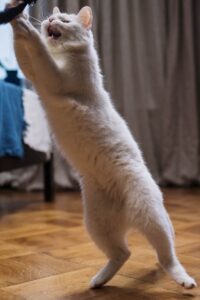Protecting Your Furniture: Effective Strategies to Prevent Cat Scratching
 Cats are wonderful companions, but their natural instinct to scratch can wreak havoc on your furniture. While scratching is a normal behavior for cats, it can be frustrating for pet owners. However, it’s important to understand that scratching is essential for their well-being. It helps them stretch their muscles, mark their territory, and maintain healthy claws. Instead of trying to eliminate the behavior entirely, the key is to redirect your cat’s scratching tendencies to appropriate surfaces. In this article, we will explore effective strategies to prevent your cat from scratching your furniture, while promoting their natural instincts and providing them with alternatives.
Cats are wonderful companions, but their natural instinct to scratch can wreak havoc on your furniture. While scratching is a normal behavior for cats, it can be frustrating for pet owners. However, it’s important to understand that scratching is essential for their well-being. It helps them stretch their muscles, mark their territory, and maintain healthy claws. Instead of trying to eliminate the behavior entirely, the key is to redirect your cat’s scratching tendencies to appropriate surfaces. In this article, we will explore effective strategies to prevent your cat from scratching your furniture, while promoting their natural instincts and providing them with alternatives.
Understanding Your Cat’s Scratching Behavior:
Before we delve into the solutions, it’s important to understand why cats scratch. Cats scratch for various reasons, including:
- Territory Marking: Cats have scent glands in their paws, and scratching helps them mark their territory both visually and olfactorily.
- Nail Maintenance: Scratching helps cats shed old layers of their claws, allowing new growth to emerge.
- Stretching and Exercise: Scratching posts provide an excellent opportunity for cats to stretch their muscles and release pent-up energy.
Strategies to Prevent Scratching:
- Provide Suitable Scratching Surfaces:
The first step in preventing furniture scratching is to offer your cat attractive alternatives. Invest in sturdy scratching posts or boards that are tall enough for your cat to fully stretch. Consider the material preferences of your cat, as some may prefer sisal rope, while others may prefer carpet or wood. Place these posts near the furniture they tend to scratch, as well as in other areas of the house. Encourage your cat to use them by using toys, treats, or catnip to entice them.
- Make Furniture Unattractive to Scratch:
While providing alternative scratching surfaces, it’s crucial to make your furniture less appealing. Try the following methods:
- Double-Sided Tape: Cats generally dislike sticky surfaces. Applying double-sided tape to the edges or arms of your furniture can deter them from scratching.
- Aluminum Foil: The noise and texture of aluminum foil can discourage cats from scratching. Cover the targeted areas with foil temporarily, and gradually remove it as the behavior changes.
- Plastic Furniture Covers: Protective plastic covers can act as a barrier and prevent access to furniture surfaces.
- Anti-Scratch Sprays: There are commercial sprays available that emit scents cats find unappealing. Apply these sprays on furniture surfaces to discourage scratching.
- Positive Reinforcement:
When your cat uses the appropriate scratching surfaces, reward them with praise, treats, or playtime. Positive reinforcement helps them associate the scratching post with positive experiences, increasing the likelihood of using it in the future.
- Trimming Your Cat’s Claws:
Regular nail trims can reduce the damage caused by scratching. Get your cat accustomed to having their paws touched from an early age, and use cat-specific nail clippers to carefully trim the tips of their claws. Be cautious not to trim too close to the quick, as it can cause bleeding and discomfort.
- Temporary Furniture Protection:
While training your cat, it may be necessary to protect your furniture temporarily. Use washable slipcovers or blankets to cover the targeted areas. This prevents direct access to the furniture and minimizes damage until the cat learns to redirect their behavior.

Get Cat Language Bible
What furniture cats like to scratch?
When it comes to cats and their scratching behavior, not all furniture is created equal in their eyes. Cats have certain preferences when it comes to the surfaces they choose to scratch. By understanding their preferences, you can provide them with suitable options and protect your valuable furniture. Here are some furniture choices that cats often find appealing for scratching:
- Sisal Rope or Fabric: Many cats are attracted to the texture of sisal rope or fabric. Sisal is a natural fiber that provides a satisfying scratching experience for cats. You can find scratching posts and cat trees covered in sisal material, which makes them an excellent choice for your feline friend.
- Carpeted Surfaces: Cats often enjoy scratching on surfaces with a texture similar to carpets. Furniture with carpeted areas, such as cat condos or scratching towers, can be enticing for them. The looped or textured fabric provides a satisfying sensation for their claws.
- Wood: Some cats have a preference for wooden surfaces. They enjoy the feeling of sinking their claws into the grain of the wood. Wooden scratching posts or cat trees with wooden elements can be a hit with these cats. Consider adding different levels and angles to the structure to make it more appealing.
- Cardboard: Cardboard scratchers are highly popular among cats. The rough texture of cardboard provides an excellent surface for scratching and allows them to dig their claws in. Cardboard scratching pads or loungers can be placed horizontally on the floor or mounted on a wall for your cat’s convenience.
- Upholstered Furniture: While it may be disheartening to see your cat targeting your beloved couch, some cats are drawn to upholstered furniture. The softness and texture of upholstery can be appealing to them. To protect your furniture, provide alternative scratching options nearby, such as scratching posts covered in similar fabric.
Remember, each cat has individual preferences, so it may take some trial and error to find the right scratching surfaces that your feline friend finds enticing. Observe your cat’s scratching behavior and adjust accordingly. Providing a variety of options, such as different materials and orientations, can increase the chances of finding the perfect fit for your cat’s scratching needs.
By understanding the types of furniture that cats are naturally drawn to scratch, you can redirect their behavior to appropriate surfaces and save your prized possessions from their sharp claws. Remember to provide enticing alternatives and make those options readily available throughout your home. With patience and perseverance, you can coexist happily with your feline companion without sacrificing your furniture.

Get Cat Language Bible
Conclusion:
Preventing your cat from scratching furniture requires patience, consistency, and understanding. By providing appropriate scratching surfaces, making furniture unappealing, reinforcing positive behavior, and keeping your cat’s claws trimmed, you can protect your furniture without compromising your cat’s well-being. Remember, it’s crucial to never punish your cat for scratching furniture, as it will only create fear and anxiety. Instead, focus on redirecting their behavior and providing them with suitable alternatives. With time and effort, you can achieve harmony in your home while ensuring your feline friend remains content and mentally stimulated.

Leave a Reply